
All categories
Featured selections
Trade Assurance
Buyer Central
Help Center
Get the app
Become a supplier

(52 products available)





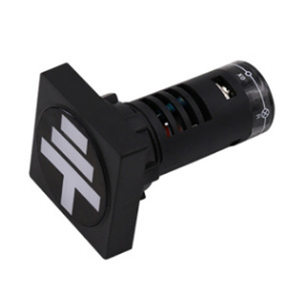



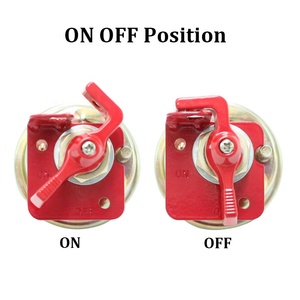



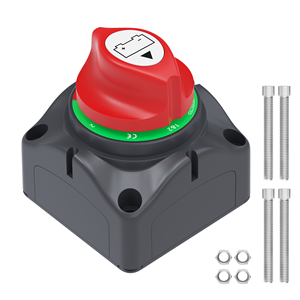


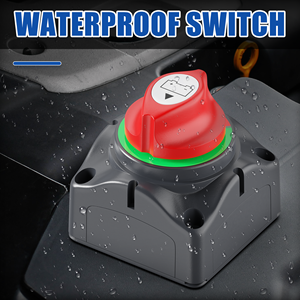
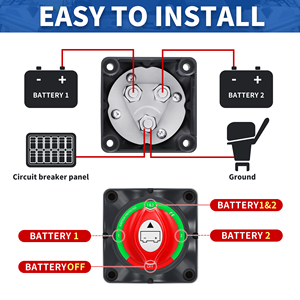

















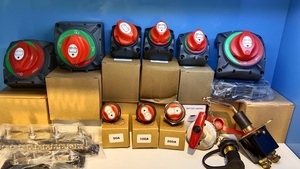

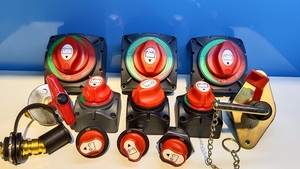









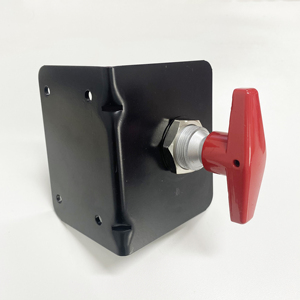


Rotary Switches
A rotary battery isolator switch allows users to select different positions by turning a knob or dial. One position is often the isolating mode, where the battery is disconnected from the load. Other settings may include connecting multiple batteries in parallel or series configurations to increase either voltage or current capacity.Being able to connect batteries in different configurations means these switches add functionality for situations with more than one battery, like RVs, boats, or emergency vehicles.
Sliding Switches
A user slides a lever or bar on this battery isolator switch to open or close electrical circuits. The mechanism is typically situated on the top, so the user swipes their hand across to activate it.Depending on the model, there are either on/off settings or multiple settings for connecting different combinations of battery banks. These switches are found in mobile work trucks, command centers, and any vehicle that requires fast access to the isolator.
Dual Battery Isolator Switches
A dual-battery isolator switch connects one main battery with another auxiliary or house battery. This keeps the house battery charged from the alternator while isolating it from the main battery when the engine is off. Many dual battery switches are designed to work automatically by sensing when the vehicle is running and connecting the batteries so the alternator can charge both.
Electronic or Smart Switches
These intelligently control how batteries are connected or disconnected from loads. They use MCU/digital control rather than mechanical parts, making them compact and offering features like automated isolation and data feedback.An example is a Smart Battery Isolator (SBI) that automatically isolates batteries and connects them based on charge levels and preset parameters. These are popular in marine applications, backup power systems, and any scenario where battery management requires more sophistication.
Back-up Power Systems
Battery isolated switches provide a means to safely disconnect loads from backup power banks. This is particularly critical in two scenarios where backups are mandatory. The first is where power loss endangers life/safety systems, like hospitals, telecoms, etc. The second is where data integrity and continuity of operations are key, such as in data centers. The ability to safely isolate batteries allows maintenance to be performed and ensures systems will function correctly in a power outage.
Uninterruptible Power Supply (UPS) Systems
UPS systems provide temporary power using an incoming energy source stored in batteries until normal conditions resume. Isolator switches are used here to safely disconnect batteries for replacement/maintenance while keeping the connected load powered. They are also used to isolate redundant battery configurations so one can be serviced without shutting down the UPS.
Telecommunications and Radar Systems
As discussed previously, isolator switches play an important role in isolating backup batteries for remote telecom/radar installations. This ensures the backup power can be reliably isolated or connected without risking damage to sensitive electronic equipment. It also allows for easy battery maintenance/replacement in the field, which is often done under harsh environmental conditions.
Emergency Lighting and Safety Systems
These systems are designed to ensure safety during power outages. They all rely on battery isolator switches to connect/disconnect the batteries that power emergency lighting, alarms, exit signs, etc. This isolation capability is crucial for maintaining the reliability of safety systems and ensuring that batteries can be easily swapped out when depleted.
Electric Vehicles (EVs) and Hybrid Vehicles
These vehicles have complex battery systems that require switches. They isolate different battery packs/sources (high voltage drive vs low voltage auxiliaries). The switches let the main load be connected/disconnected from different battery banks as needed during operation. This helps protect the driver from high voltages and allows workers to service the vehicle's electrical system safely.
Key Features
There are several key features that users value when choosing a battery isolator switch. They include:
Weatherproof/Waterproof Design: As mentioned previously, the isolator switches protect the internal electronic components from moisture/dust/sand, whether used indoors or in outdoor environments. Look for isolator switches with sealed enclosures and protective gaskets.
Multiple Positions:Rotary isolator switches easily connect/disconnect batteries in various configurations. This has the effect of providing greater operational flexibility/functional diversity, as the same switch can be used for several different key situations depending on how the batteries need to be connected at any given time (in parallel, series, off, etc.).
Heavy-Duty Construction:
As isolated switches are used in harsh industrial applications, manufacturers make their housings/switch internals from corrosion-resistant materials such as stainless steel, aluminum, and brass. The switches are designed to withstand impact, vibration, and extreme temperatures.
Load-Breaking Capability:
The switches enable the connected load to be safely switched off/broken while the system is under load/operating. This avoids the need to manually shut down equipment or detach the load cable from the battery DC power, which can be dangerous if it's a high-current industrial machine.
Properly installing a battery isolator switch prolongs the life of the vehicle's batteries. It also protects electrical systems from damage due to power surges.
Choosing the Right Location
The area close to the battery installation site should be easily accessible, mountable, and free of moisture. A common choice is the vehicle's engine bay or battery compartment. Avoid areas with high heat or incompatible with electronic equipment.
Mounting the Switch
After Selecting the appropriate location, users can mount the isolator switch securely using the supplied screws/bolts or through a rugged drill/within rivet fasteners.) Again, ensure the isolator is mounted safely so it won't come loose or have a tendency to jiggle while in motion.
Wiring the Switch
Per the user's manual, connect one terminal of the switch to the battery positive terminal using a cable that produces the same gauge as the load to be carried through the isolator. Then connect the other terminal to the vehicle's electrical system secure it with terminal ends. Again, use a cable of the same gauge as the load to carry the current.
Safety Precautions
Users should disconnect the vehicle from live power before doing anything with the wiring to avoid electrocuting themselves/t damaging the vehicle's electronic system. Any work involving the battery or electrical systems should be done wearing insulating rubber gloves and goggles. Proper isolator switches have covers that prevent accidental contact with live wires.
The battery isolator switches should always be examined, maintained, and repaired to deliver optimal performance and lifetime. They also need to ensure ongoing reliability and effectiveness in critical power system applications in harsh industrial environments. Here are some ways one can go about maintaining/replacing/removing various types of battery isolator switches.
Rotary, Push, and Turn Key Switches
These are mechanical switches that typically see the most wear/will require maintenance/replacement. For rotary switches, users must regularly inspect the rotating mechanism for grease/dirt build-up or signs of wear preventing smooth operation. Lubricate the area using a good-quality dry lube that won't collect dust or debris. Customers should replace the switch if there is any damage to the housing or the electrical contacts from internal shorts that caused sparks.
Sliding and Remote Switches
The exposure to dust/particles can cause sliding switches to stick/wear out, so users need to regularly clean any residue from the switch. Covers could be fitted to isolate the switches from environments with fine dust/particles. Remote isolator switches use receivers/transmitters, particularly susceptible to damage from moisture/the harsh chemicals often used in industrial applications, and are required to be regularly checked for corrosion; RF or water-resistant covers are standard for such isolator switches.
Electronic/Smart Isolator
These should really just be visually inspected for burn spots or cracks on the external enclosure caused by overheating or exposed to high temperatures in industrial environments. Electronic isolators integrate sensors/MCUs prone to internal faults due to power surges. Always ensure the area is well-ventilated, and the electronic components are kept dust-free.
Temperature Resistance
Battery isolator switches should be built to operate safely and effectively at extreme temperatures, such as high heat in engine bays or freezing temperatures in the arctic. Protecting the internal components guarantees dependability in all outdoor conditions.
Vibration Resistance
Users must ensure isolator switches are designed to withstand constant vibration without compromising safety. Features like locking mechanisms/more rugged switches and secure mounts help reduce the likelihood of failure caused by excessive vibrating. They are particularly important for extended outdoor use on heavy equipment/smart vehicles.
Material Quality
The materials used to construct the housing and internal contacts of the isolator switch directly impact its strength and robustness. Corrosion-resistant materials, such as stainless steel, aluminum, or brass, are critical for an isolator switch's durability. The same goes for oxidization at any point; this can lead to switch failure.
Load Disconnection
Whether D.C or A.C powered, Battery isolator switches should always be load-breaking; this allows users to disconnect the battery from the electrical load safely, even if the system is powered. This provides an added safety measure for industrial personnel who must perform maintenance/replacements without electrocuting themselves.
Isolation of Multiple Batteries
This is ideal for power applications with more than one battery. It allows users to isolate individual batteries from the load/charge as needed. This helps ensure that no single battery becomes over/undercharged while also allowing parts to be taken offline for servicing without shutting down the entire system.
Arc Suppression
The switches are designed to minimize or eliminate arcing when connecting/disconnecting the battery from the load. Arcing can damage electrical equipment, posing a fire hazard/electrocution risk. IS isolate switches equipped with arc suppression technology prevent this from happening.
Visual Indicators
These readily allow users to see whether the switch is in the open or closed position at a glance, reducing the risk of error and ensuring proper isolation occurs before any maintenance work is started.
In very simple terms, a battery isolator switch connects/disconnects batteries from their loads in industrial applications requiring backup power, emergency lighting, telecommunications, electric vehicles, RVs, and boats.
How well they withstand extreme temperature/vibration, corrosion resistance, material quality, and tangible feel all positively influence the quality of these battery isolators.
By letting repairs or maintenance be done safely without turning off the entire system and electrocuting people, load-breaking capability makes it a lot easier to do industrial maintenance.
Outdoor switches require additional protection from the dust/water/mud/debris/salt/etc. and must be weatherproof/waterproof. In contrast, indoor isolators may not need such extreme protection but should still be robust and durable.
They are important as they clearly show whether a switch is open or closed, thus reducing erroneous battery connections/disconnections. This is important for ensuring safety during battery maintenance or changing.